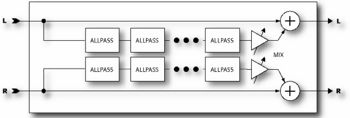Phaser
A phaser works by cascading a series of "allpass filters" and then mixing the processed signal with the input. The allpass filters cause phase shift and at certain frequencies the amount of phase shift will be exactly out of phase with the input so the mixed signal will have notches at those frequencies. The Axe-Fx Phaser is extremely powerful allowing from 4 to 12 stages along with a feedback control for producing even more dramatic effects. Also, the Axe-Fx phase is full stereo allowing for spatial effects as well.
The Phaser also contains a special “Vibe Mode” that recreates the classic vibe effect with astonishing accuracy. Set the ORDER control to fully clockwise to activate this mode.
NOTE: The MIX control should be set at 50% for the maximum effect.
Parameters
Basic Parameters
- ORDER - Sets the number of stages in increments of two. For classic phaser sounds set the order to four and use low feedback. For more pronounced effects increase the order. Turning this control fully clockwise puts the Phaser into “Vibe Mode” where the frequency spacings are fixed. In this mode the FREQ SPAN control has no effect.
- RATE - Controls the frequency of the Low Frequency Oscillator. Set fully CCW to sync to the Global LFO1 oscillator.
- DEPTH - Controls the sweep depth of the LFO.
- RES - Resonance control. Controls how much of the wet signal is fed back to the input. Increasing the resonance increases how sharp the notches are. Excessive values of feedback can cause instability. If this occurs decrease the feedback.
- FREQ - Sets the start frequency of the first stage filter. This in combination with the depth control controls the range over which the notches sweep.
- TEMPO - Locks the rate to the global tempo. For example, if the global tempo is 120 bpm and the tempo is set to a quarter note (1/4) then the LFO rate will be 2 Hz (120 bpm / 60 seconds = 2). To ignore the global tempo set the tempo control to NONE.
Advanced Parameters
- LFO TYPE - Selects the waveform for the LFO. The ramp types can provide falling or rising effects. Experiment with Exponential or Logarithmic types for pulsating effects.
- FREQ SPAN - Sets the span of the allpass filters. Higher values separate the resulting notches by greater amounts.
- LFO PHASE - Sets the phase difference from left to right for the LFO. When set to 180 degrees, the right notch will be a maximum when the left is a minimum and vice-versa.
